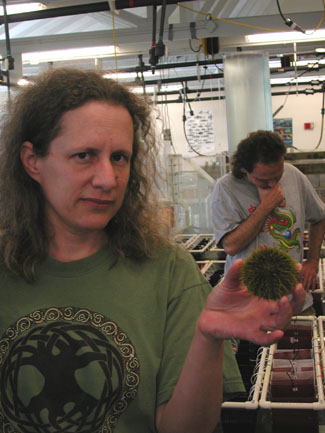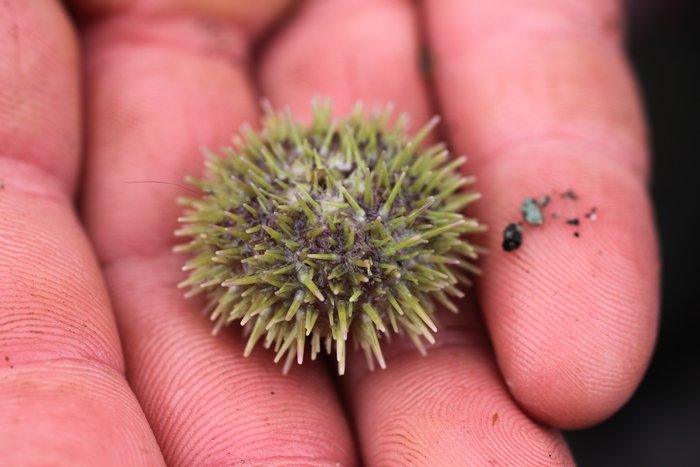 When Bowdoin Biology Department Chair Amy Johnson and Biology Research Associate Olaf Ellers published their discovery of the mechanism by which sea urchins grow in 2002, marine biologists took note. No one had yet understood how echinoderms could increase the size of their shells, or skeletal plates, without shedding them.
When Bowdoin Biology Department Chair Amy Johnson and Biology Research Associate Olaf Ellers published their discovery of the mechanism by which sea urchins grow in 2002, marine biologists took note. No one had yet understood how echinoderms could increase the size of their shells, or skeletal plates, without shedding them.
They discovered that as urchins grow, the collagenous tissue inside, outside, and between their skeletal plates softens. The shell inflates like a balloon. The collagen stretches and expands gaps between the plates from the inside, while containing them from the outside. Eventually, the tissue between the plates is reabsorbed and is replaced by hard shell. This mechanism is similar to the growth of a vertebrate skull.
The bust of Maine’s sea urchin industry now makes this information invaluable to researchers, regulators and harvesters struggling to find ways to replenish Maine’s once-bountiful sea urchin population.
While this discovery stands on its own as a bit of interesting basic biology, the bust of Maine’s sea urchin industry now makes this information invaluable to researchers, regulators and harvesters struggling to find ways to replenish Maine’s once-bountiful sea urchin population along the southern coast – while protecting remaining stocks in the north.
No one is more interested than Johnson and Ellers themselves. The pair is keenly studying environmental and genetic factors to determine the most favorable conditions for sea urchin growth. Results of their work – which currently is centering on the way in which water temperature affects growth rate – may help to create a new aquaculture industry in Maine.
sea
Sea urchin gonads have long been considered a delicacy in Japan.
Sea urchin gonads have long been considered a delicacy in Japan, where it is known as uni and consumed annually by the ton. The ideal urchin contains 25 to 30 percent roe and in today’s market can fetch anywhere from 30 cents to three dollars an animal, depending on its size, texture and firmness. In 1993, at the height of the boom in Maine’s urchin industry, 30 to 40 million pounds were harvested by roughly 2,000 divers, making it second only to lobster as Maine’s most lucrative fishing industry.
With the urchin population along the southern coast disappearing, and Maine’s northern coast facing increasing fishing pressures, commercial urchin-raising techniques are being explored and developed.
There is no sea farming of urchins yet,” says Johnson. “We don’t really know how to do it or whether it would be economically viable. What we’re trying to do is develop the science that would make it possible.
“There is no sea farming of urchins yet. We don’t really know how to do it or whether it would be economically viable. What we’re trying to do is develop the science that would make it possible.”
Scientists across New England are working on various aspects of sea urchin research. Two experimental hatcheries have been built, for instance — a commercial one in Lubec, Maine, and another developed by the University of New Hampshire. Millions of young sea urchins are being produced at these hatcheries which, according to Ellers, “could be transplanted out, seeded out to areas that have been devastated by fishing. But we don’t know how well those little ones will survive. It may be that you only get one survivor for every million you farm out.”
What is needed is more data on what makes urchins thrive, reproduce and grow.
 In their laboratory at Bowdoin’s Coastal Studies Center, Johnson and Ellers are raising several hundred urchins in self-designed tanks that replicate water temperatures found along the Maine coast at various times during the year – spring, winter, and at the seasonal average temperature of eight degrees centigrade. The animals range in size from a pinhead to a fist, and feast on a specially designed chow of protein and algae.
In their laboratory at Bowdoin’s Coastal Studies Center, Johnson and Ellers are raising several hundred urchins in self-designed tanks that replicate water temperatures found along the Maine coast at various times during the year – spring, winter, and at the seasonal average temperature of eight degrees centigrade. The animals range in size from a pinhead to a fist, and feast on a specially designed chow of protein and algae.
By controlling their food and water temperature, Johnson and Ellers can gather information on how these elements affect growth – and the degree to which genetics plays a part.
They had hoped to have their sample from a single urchin bed, says Johnson, “but in over 100 dives in Southern Maine, Robert Russell of the Maine Department of Marine Resources (DMR) couldn’t find any of their populations that had enough for us to collect from one site.”
Findings from their research is of interest to the DMR, she says, because regulators need to know whether all populations are behaving in the same way – and if not, why – in order to make population predictions for the fishery.
The most significant finding their work has turned up so far concerns water temperature. Preliminary data show that urchins grow slower at colder temperatures, but become ultimately bigger and thus have larger yields of roe. They grow faster in warmer water, and with proper feeding can likely reach fishery size within a year. They are, however, more susceptible to disease.
In the natural environment, urchins require six years to come to full maturity.
“It’s important to know that growing sea urchins in natural temperatures isn’t going to cut it for farm-raised urchins, but that just tells you what not to do. It doesn’t tell you how to do it. We can’t afford to wait for six years, because these animals are going to be too scarce.”
“It’s important to know that growing sea urchins in natural temperatures isn’t going to cut it for farm-raised urchins,” says Johnson, “but that just tells you what not to do. It doesn’t tell you how to do it. We can’t afford to wait for six years, because these animals are going to be too scarce.”
Ellers says he and Johnson also are attempting to identify the protein responsible for the development of the urchin’s growth collagen. “If you found the growth factor that works, you could inject them to make them grow faster,” he says, “but it’s very labor-intensive research. You have to go through the proteins one at a time and hope it works.”
Meanwhile, the pair also is experimenting with urchin-tagging technology that would help aquaculture facilities recoup money on animals released back into the wild. Specifically, they are experimenting with magnetic “branding” technique that would label them according to their hatchery of origin.
Johnson says she began sea urchin research, in part, “because I was looking for research areas that could connect in important ways to the state of Maine.” Hopefully, this research will yield innovative strategies for restoring and protecting this important marine resource.
Johnson and Ellers’ research is supported, in part, by a grant from the Maine Sea Grant Program.
Originally published on the Bowdoin College website.